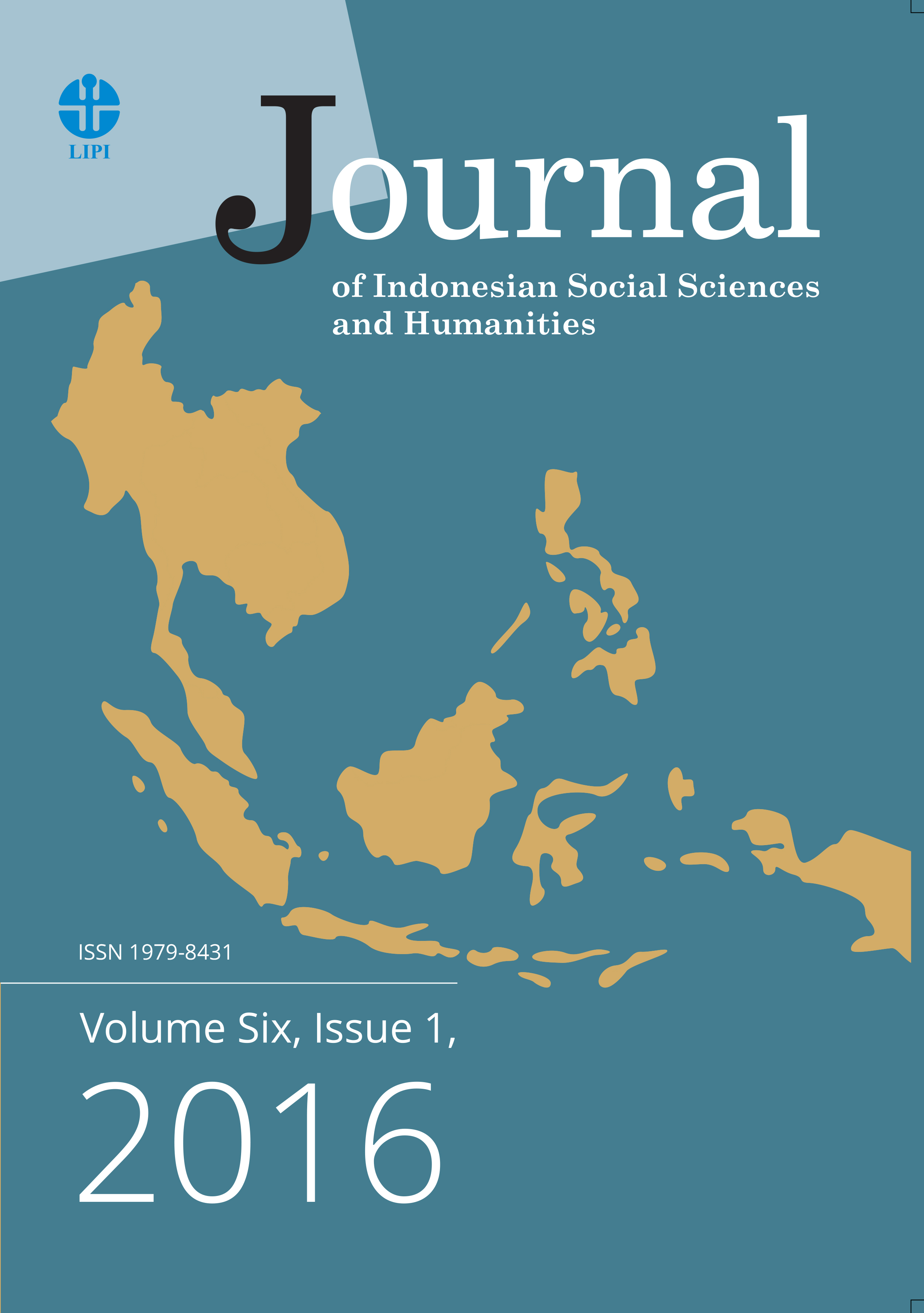Managing Conflict Through: Cross-Border Cooperation: A Study at the Indonesia-Timor Leste Border
Keywords:
Conflict management, Cross-border cooperation, Indonesia-Timor Leste’s borderAbstract
Since the separation of Timor Leste from Indonesia in 2002, disputes over the border area have existed and have occasionally escalated to be communal conflicts. Due to the involvement of people to people relations, government to government negotiation is not enough to resolve these conflicts. Hence, both countries established cross-border cooperation as an alternative. This research analyzed the role of cross-border cooperation in managing communal conflicts in the border area between the Timor Tengah Utara District of Indonesia and the Oecussi District of Timor Leste. The research was conducted in a qualitative approach, while the data was collected by interview, observation, and literature review. This study showed that cross border cooperation played a significance role in managing the conflict by reducing violence, building and maintaining social relations, as well as improving the economic development of the local people.
References
Addendum No.1 to the Provisional Agreement between the Government of the Republic of Indonesia and the Government of the Democratic Republic of Timor-Leste on the Land Boundary, 21 June 2013.
Arrangement between the Government of the Republic of Indonesia and the Government of the Democratic Republic of Timor-Leste on Traditional Border Crossings and Regulated Markets, 11 June 2003.
Berg, B. L. (2001). Qualitative research methods for the social sciences. Boston: Allyn&Bacon.
Border Management Authority of the Timor Tengah Utara District. (2014). Laporan rapat koordinasi dan dialog penyelesaian batas negara RI–RDTL tahun 2014. Kefamenanu, 9 August 2014. Border Management Authority of the Timor Tengah Utara District. (2012). Profil perbatasan RIRDTL. Kefamenanu: Sains Group Consultant.
Fisher, R. J. (2011). Method of third party intervention. In B. Austin, M. Fischer, & H.J. Giessmann (eds.), Advancing Conflict Transformation-The Berghof Handbook II (pp. 157-182). Opladen/Framington Hills: Barbara Budrich Publishers.
Gerfert, S. (2009). Cross-border cooperation: Transforming borders. Taken from http://essay.utwente.nl/60149/1/BSc_S_Getfert. pdf[accessed August 27, 2014].
Government of Timor Tengah Utara District. (2013). Laporan konflik masyarakat Nelu kab. TTU dengan masyarakat Leolbatan desa Costa, distric Oecusse – RDTL. Kefamenanu, 25 November 2013.
Hendrapati, M. (2014). Implication of the ICJ decision respecting Sipadan–Ligitan case towards base points and maritime delimitation. International Journal of Sciences: Basic and Applied Research (IJSBAR), 14(1), 374-393.
Lee, S. & Forss, A. (2011). Dispute resolution and cross-border cooperation in northeast Asia: Reflections on the nordic experience (Asia Paper). Stockholm: Institute for Security and Development Policy.
Memorandum of Understanding between the Indonesian National Police and the National Police of the Democratic Republic of Timor-Leste on Cooperation in Preventing and Combating Transnational Crimes and Developing Police Collaboration, 29 July 2009.
Miller, C. E. (2005). A glossary of terms and concepts in peace and conflict studies (2nd Ed.). San Jose: University for Peace.
Ministry of Foreign Affairs of the Republic of Indonesia. (2014). Daftar perjanjian internasional tersimpan di kementerian luar negeri, Republik Indonesia. Taken from http://treaty.kemlu.go.id/index.php/treaty/export?Treaty[country_id]=11&Treaty[work_type_id]=1&Treaty[]&format=pdf [accessed December 30, 2014]
National Border Management Authority of the Republic of Indonesia. (2011). Desain besar (grand design) pengelolaan batas wilayah negara dan kawasan perbatasantahun 20112025. Jakarta: BNPP.
National Statistics Directorate of Timor Leste. (2013). Timor-Leste in figures 2013. Dili: NSD.
Provisional Agreement between the Government of the Republic of Indonesia and the Government of the Democratic Republic of Timor-Leste on the Land Boundary, 8 April 2005.
Raharjo, S. N. l. (2014). Analisis dan upaya penyelesaian konflik antara warga perbatasan Timor Tengah Utara, Indonesia dengan warga distrik Oecussi, Timor Leste pada 2012-2013. Jurnal Pertahanan, 4(1), 169-188.
Seo, Y. (2012, July 27). Kantor imigrasi Timor Leste lewati perbatasan. Taken from http://www.tempo.co/read/news/2012/07/27/058419671/ Kantor-Imigrasi-Timor-Leste-Lewati-Perbatasan [accessed October 14, 2013].
Sitohang, J., et al. (2009). Masalah perbatasan wilayah laut Indonesia di laut Arafura dan laut Timor. Jakarta: LIPI Press.
Sousa, L. D. (2012). Understanding European cross border cooperation: A framework for analysis. Journal of European Integration, 1-19. doi:10.1 080/07036337.2012.711827
Starr, H. & Thomas, G. D. (2005). The nature of borders and international conflict: Revisiting hypotheses on territory. International Studies Quarterly, 49, 123-139.
Swanström, N. L. P. &Weissmann, M. S. (2005). Conflict, conflict prevention and conflict management and beyond: A conceptual exploration. Uppsala: the Central Asia-Caucasus Institute & Silk Road Studies Program.
Swanström, N. L. P. (2002). Regional cooperation and conflict management: Lessons from the Pacific rim. Uppsala: Department of Peace and Conflict Research.
Wuryandari, G. (2010, May 21). Mencari solusi damai sengketa perbatasan di Timor. Taken from http://politik.lipi.go.id/in/kolom/politik-internasional/280-mencari-solusi-damai-sengketa-perbatasan-di-timor.html [accessed December 23, 2013].
Zartman, W.I. (1997). Introduction. In W. I. Zartman & J. L. Rasmussen (eds), Peacemaking in international conflict: Methods &techniques (1-22). Washington: United States Institute of Peace Press
Downloads
Published
Issue
Section
License
Copyright (c) 2016 Sandy Nur Ikfal Raharjo

This work is licensed under a Creative Commons Attribution-ShareAlike 4.0 International License.
Authors who publish with this journal agree to the following terms:
1. Authors retain copyright and grant the journal right of first publication with the work simultaneously licensed under an Attribution-ShareAlike 4.0 International (CC BY-SA 4.0) license. This license allows others to remix, adapt, and build upon the work, as long as they credit the author and license their new creations under the same terms.
2. Authors may enter into separate, additional contractual arrangements for the non-exclusive distribution of the journal’s published version of the work (e.g., posting it to an institutional repository or including it in a book), provided there is an acknowledgment of its initial publication in this journal.
3. Authors are permitted and encouraged to post their work online (e.g., in institutional repositories or on their personal website) prior to and during the submission process, as this can lead to productive exchanges and increase citations of the published work (See The Effect of Open Access ).


















